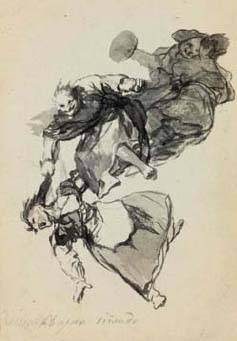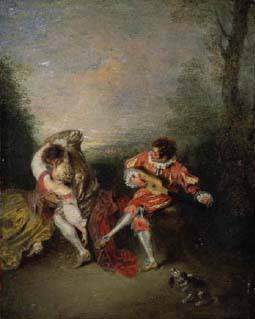IMAGES
Francisco de Goya – Bajar riñendo
GOYA: 3 REDISCOVERED DRAWINGS PRESUMED LOST FOR OVER 130 YEARS REALISE A TOTAL OF £4 MILLION / $7.9 MILLION / €5 MILLION AT CHRISTIE’S IN LONDON ]]>
July 9th 2008 – Three rediscovered drawings by Francisco José de Goya y Lucientes (1746-1828) were sold today (8 July) at Christie’s in London for a combined total of £4,010,150 / $7,908,016 / €5,032,739. Last recorded at a landmark auction of works by the artist in Paris in 1877, the drawings have been missing and presumed lost ever since, and represent the most important grouping of sketches by the artist to be sold at auction in over 30 years. The top lot was Bajar riñendo (Down they come) which sold for £2,281,250 / $4,498,625 / €2,862,969, a world record price at auction for a work on paper by the artist. The three drawings, which were sold individually, had been expected to realise a total in excess of £2 million.
At Christie’s auction of Important Old Master and British Pictures this evening (8 July), La Surprise, a recently rediscovered masterpiece by Jean-Antoine Watteau (1684-1721), is expected to realise £3million to £5 million. The painting had been missing for almost 200 years, presumed to have been destroyed, and was previously known only by a copy in the Royal Collection at Buckingham Palace and through a contemporary engraving. It was found in the corner of a drawing room in a British country house during aChristie’s valuation last year.
Benjamin Peronnet, Director and International Head of Old Master and 19th Century Drawings, Christie’s: “We are very pleased with the prices realised for these three exceptional drawings by Goya, last recorded in the landmark auction ‘105 dessins par Francisco Goya’ in Paris in 1877, and lost ever since. ‘Bajar riñendo (Down they come)’ was the top lot having attracted bids from a number of international collectors before selling for £2.28 million and setting a world record price at auction for a work on paper by the artist. We are thrilled to have exhibited these works to the public for the first time in over 130 years at Christie’s rooms in Madrid, New York and London, and to have welcomed bidding fromaround the world at today’s sale. Each one of the drawings is from one of the artist’s celebrated private albums, and they illustrate to perfection the inexhaustible fertility of Goya’s imagination, and the creativity and flair that see him recognised as arguably the first modern artist.”
On 2 April 1877, a landmark auction in Paris offered a series of 105 drawings taken from Goya’s celebrated private albums. Goya had started assembling personal notebooks or journals in 1796 and gradually filled the pages with imaginative drawings of people in various moods and situations, as both individuals and in groups. The drawings sold today at Christie’s are taken from two of the artist’s albums, and present three differing styles and subjects. They were offered from a Swiss private collection. The owners recently contacted Christie’s specialists who confirmed that the drawings were missing works from the hand of the great Spanish artist. The drawings are still on the mounts that were made specifically for the 1877 auction, and one can still see the pinholes at the top of each mount from the tacks used to hang them unframed on the walls of the Hôtel Drouot. Owing to the fact that they have never been framed nor exposed to light, the three drawings are in exceptional condition.
Bajar riñendo (Down they come) was originally in Album D, also called Witches and Women, which was used circa 1819-1823 and contained very few sheets; other than the one sold today at Christie’s, only 21 drawings are known to exist and all but one of these are in public institutions. The drawing shows four women fighting as they fly through the air. One has a broad smile and pulls the hair of another, whoscreams in pain. The drawing had been expected to realise £800,000-£1,200,000 and sold for £2,281,250 / $4,498,625 / €2,862,969, a world record price at auction for a work on paper by the artist.
The constable Lampiños stitched inside a dead horse was originally from Album F, also called Images of Spain, which was used circa 1812-1820. It sold today for £769,250 / $1,516,961 / €965,409. The drawing has an extensive inscription at the bottom in which Goya outlines the story behind the image: in Saragossa in the middle of the 18th century, the peasants revolted against a local official called Lampiňos who had been persecuting students and women in the city. The people sought revenge and stitched him inside adead horse, where, according to the inscription, he survived a whole night. A subsequent drawing by the artist, now in the Metropolitan Museum, New York, shows the eventual death of Lampiños who was injected with lime by syringe. The present drawing depicts Lampiños stitched inside the horse, with a great arch in the background and barking dogs surrounding the anguished prisoner.
The third drawing, Repentance, also comes from Album F, and sold today for £959,650 / $1,892,430 / €1,204,361. A seated man is praying in front of a cross, his eyes raised and his mouth open in an expression which prefigures Edvard Munch’s Scream. The fluent manipulation of the wash and the minute brush strokes delineating the features are marvellously preserved.
Follow us on:


